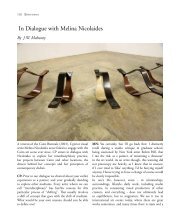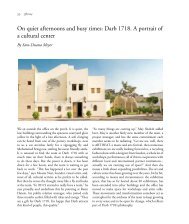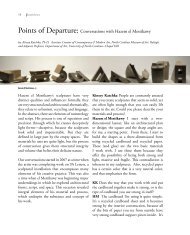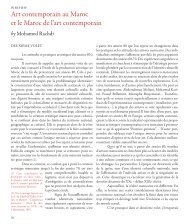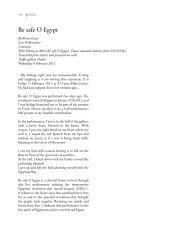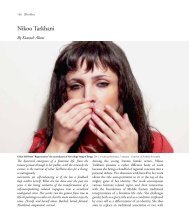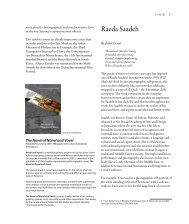full essay - Contemporary Practices
full essay - Contemporary Practices
full essay - Contemporary Practices
- No tags were found...
Create successful ePaper yourself
Turn your PDF publications into a flip-book with our unique Google optimized e-Paper software.
Essay85Good Government in the City, 1338-40 (detail)(fresco), Lorenzetti, Ambrogio (1285-c.1348). Palazzo Pubblico, Siena, Italy. The Bridgeman Art Library.Saïd’s own versions of those subjects. The same artisticexchange seems to have occurred between some of Saïd’sworks and Angelopoulo’s female peasant portraits andGreek views, or Charles Boeglin’s landscapes. The closefriendship between Saïd and several foreign painters inEgypt seems clear when looking at the various portraitshe painted of them, such as that of Georges Khoury(1921), Aristomenis Angelopoulo (1934), CharlesBoeglin (1936) or Dimitri Litsas (1940).Saïd’s Interpretation of Western ArtAs per the above, Western influences throughoutSaïd’s œuvre are present in various ways, yet they arecomplex and eclectic. Art historians have discussed atlength how learning from Western Art was importantand necessary for the 20th century Egyptian artist as astepping-stone to form his own visual language. NadaShabout highlights this as she writes that ‘it was a meansof liberating themselves from a restrictive, stagnanttradition’ . This is, in many aspects, what MahmoudSaïd achieved and it is probably one of the reasons whyhe has been identified as one of the founding fathers ofModern Egyptian Art. The way in which Saïd employedWestern aesthetics and interpreted them with hisown style will therefore be discussed in the followingparagraphs, leaning on several specific examples of Saïd’sworks. Yet, Saïd’s first-hand encyclopaedic knowledgeof Western art through his travels and his relationshipwith many foreign artists did not impede him in usingeverything he learned, heard and observed, to serve hisown purpose. He clearly defined what he was searchingfor in his paintings when he wrote to Beppi-Martin in1927: ‘what I am looking for is radiance rather thanlight. What I want is internal light, not surface light, thatblazing and deep light of some of the Limoges enamelwork that can be found in the Cluny museum, or in thestain-glass windows of Chartres cathedral; or the onein Barcelona. Surface light pleases for a minute or anhour while internal light captivates slowly, but once itappears, it imprisons us, it possesses us’ . It appears fromthis extract that Saïd wanted to grasp the intangible.What he visited and admired throughout his Europeantravels, seems to have been one of the main catalyststhat paradoxically made him reach beyond Western



